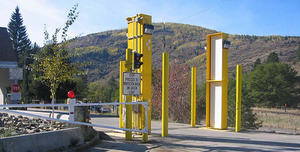DetectionGAO: $4 billion border radiation detectors program a bust
The Government Accountability Office (GAO) reported Wednesday that the $4 billion program to install radiation detectors at U.S. border crossings yielded few tangible results; the detection machines were too big for border inspection lanes, and the software for the Cargo Advanced Automated Radiography Systems also was not up to the task; DHS: “We are mindful of getting something delivered that has a credible basis for the implementation plan that follows”

Installed portal radiation monitor // Source: pnl.gov
DHS spent billions of dollars on detecting machines to intercept nuclear terrorists that were too big for border inspection lanes, the Government Accountability Office (GAO) reported Wednesday. GAO says this was “Because during the first year or more of the program,” the auditors said, the two DHS units involved — the Domestic Nuclear Detection Office and Customs and Border Protection — “had few discussions about operating requirements at ports of entry.”
“CBP officials said they made it clear to DNDO,” the report said, “that they did not want the [nuclear detecting] machines because they would not fit in primary inspections lanes and would slow down the flow of commerce through these lanes and cause significant delays.”
Jeff Stein writes in the Washington Post that that the GAO says software for the Cargo Advanced Automated Radiography Systems (CAARS) also was not up to snuff: “a key part of the machine needed to identify shielded nuclear materials automatically … did not mature at a rapid enough pace to warrant acquisition and deployment.”
Moreover, DHS budget proposals also hid “the actual status of the program,” the GAO said. “For example, the fiscal years 2010 and 2011 DHS budget justifications both cited that an ongoing CAARS testing campaign would lead to a cost-benefit analysis,” the report said. “However, DNDO officials told GAO that when they cancelled the acquisition part of the program in 2007, they also decided not to conduct any associated cost benefit analysis.”
AP reported that the leaders of the Senate Homeland Security and Governmental Affairs Committee, Joseph Lieberman (I-Connecticut) and Susan Collins (R-Maine) “slammed the department for not having a strategic plan to develop critical technology that could prevent a nuclear terrorist attack on the U.S.”
“We’re not happy or satisfied with progress on the whole nuclear detection architecture,” Lieberman said.
Stein notes that DHS’s nuclear detection program has been troubled for years, having spent more than $4 billion since 2003 with nothing to show for it.
HS said it’s working on it. AP quotes DHS deputy secretary Jane Holl Lute telling the Senate Homeland and Governmental Affairs committee, “We are mindful of getting something delivered that has a credible basis for the implementation plan that follows.”
